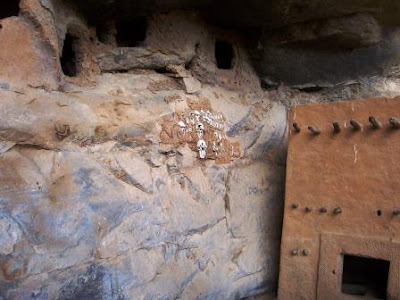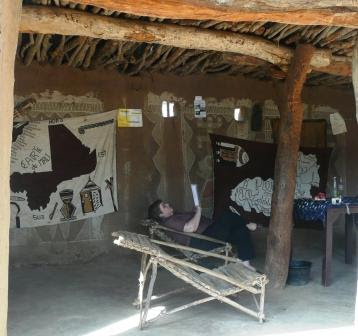Rice as far as the eye can see. Note the fishing
baskets in the water
We caught this ferry across the Bani River to Djenne
We left Bamako at 5am on Tuesday for Bandiagari via Djenne. Mali is
full of surprises and the area around Djenne was certainly one of them. There are
huge wetlands/floodplains where rice is grown. They also seem to grow millet everywhere and some maize. The cattle are very handsome too. Djenne is on an island and we had to get there by ferry over the Bani river which was quite wide. We’ve come at the end of a very good rainy season so all the rivers are full.
The Great Mosque is the largest mud building in the world
and a Unesco World Heritage Site
The Grande Marche in front of the mosque is the site
of a large market every Monday
Djenne is fascinating! It has the amazing Great Mosque which was built on an ancient site of previous mosques in 1907. The mosque is the largest mud building in the world and a wonder to behold! It was being fixed/re-plastered with mud, a job that is done every year after the rainy season, so there was scaffolding everywhere. Tourists used to be freely allowed in, but a few years ago a French magazine fashion shoot in the mosque used scantily clad models in suggestive poses and caused outrage. How culturally insensitive can you get! Our guide said that we could go in if we went to see the chief and arranged a price, but quite honestly, I was just about seeing double by this time and just wanted to sit somewhere in the shade with a cool drink. (The trouble was that we’d left Bamako at 5.30 without even a cup of coffee and after one stop at a garage where they’d let me use the toilet around the back, I was so horrified by that hole in the ground with huge, buzzing flies that I’d decided I’d just better stop drinking. We’d also had no food and now, while everyone else was resting in the shade, our guide was marching us determinedly around in the heat of the midday sun – mad dogs and Englishmen?)

Moorish style architecture on many
of the buildings
Telling our guide that we were tired and thirsty didn’t help as he just carried on. (We discovered later that no guide ever lets you go until you have been to the curio shop and spent some money – we now have a carful of things that we didn’t really want to buy, but the emotional blackmail here knows no bounds.) He took us to the women’s craft co-operative, where the chief lady who had a lovely, gentle smile and a motherly manner, greeted me with a kiss on each cheek, sat us down and began to show us Malian mud-cloths. They are made from hand-spun cotton (Mali is Africa’s largest cotton producer), then woven into long strips and sewn together, then dyed with naturally made dyes. This is a time-consuming and labour-intensive task, and they are really beautiful, but I already have some. Anyhow, we realised that there was no escape, so we chose one and then started the long discussion about price. The price we finally agreed upon must have been really good from the smile that lit her face. She disarmed me further by insisting that I take the gift of a necklace from her – this kind of generosity from really poor people is something that I’ve witnessed time and again in Ghana!
The Bani River from an alley
Dirty streets of Djenne
Djenne has great contrasts; while the culture, architecture, people and myriad sights and sounds are just a feast for the eyes, there was no feast for the nose (especially when you have a splitting headache). The slime and ooze in all the alleyways was nauseating!!!! It was no easy task to clean my shoes that evening! Part of the problem was caused by well-meaning NGOs which provided running water to most of the houses (where previously people had washed and done their laundry in the river), but neglected to supply drainage, so everything gets thrown into the alleyways.
Mostly women selling their wares at the market
The smell in this alley was really bad
Cattle, goats and a dog resting in the heat of the day
View over the mud buildings of Djenne
House of the traditional chief
The architecture has a strong Moroccan influence and most of the buildings were double storied with access to the roof and built with mud. They all have courtyards and a maze of passageways. The windows are generally like the one in the paragraph above, and each house abuts the next one. Cows, goats, sheep and chickens are kept in the streets adding to the unhygienic situation.
The restaurant where we ate such tough beef
When we finally got to the restaurant, the beef that they brought us was the toughest I’ve ever tried to eat, biltong included! The beans-with-onions and chips were very nice though, but the truth was that we needed to drink more than eat. By this time we’d realised why we felt so terrible and we’ve taken care to drink a lot ever since. We sweat all the time (perspire is too genteel a word to use when it pours off you) and this, I’ve now happily discovered, means that you seldom need the toilet – voila/QED!
The courtyard of Hotel Sevare
Yours truly having early morning coffee in the courtyard
We then travelled several more hours to Severe where we found a nice motel, Motel Sevare. All the hotels here have good, clean rooms, showers and air cons. They all have a central courtyard where meals and drinks are served. These courtyards have trees and are wonderfully relaxing places to sit in in the evenings and early mornings before 8am. The one in Sevare had bats feeding on the fruit trees there and making high-pitched squeaks much like a wind-mill.
We walked up the road to where we thought the guidebook said there was a good restaurant, but when we couldn’t find it we decided to just have yet another cold-drink and go to bed as we were exhausted anyway.























































